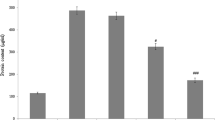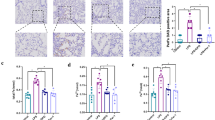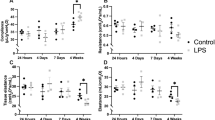Abstract
For unknown reasons, serum ferritin levels increase in patients at risk for and with acute lung injury (ALI). To improve understanding of the relationship between serum ferritin alterations and the development of ALI, we investigated the effect of iron deficiency on the serum ferritin response of rats subjected to hemorrhage. We found that rats fed an iron-deficient diet for 6 weeks had decreased hemoglobin, hematocrit, liver total iron, liver total iron-binding capacity, and liver ferritin concentrations but the same serum ferritin concentrations as rats fed a control diet. Following hemorrhage, serum ferritin concentrations increased rapidly and progressively in rats fed a control diet. Along with increases in serum ferritin concentrations, control diet rats subjected to hemorrhage also had increased lung lavage leukocyte numbers, lung myeloperoxidase activities (lung inflammation), and lung lavage protein concentrations (lung leak) compared to control diet fed rats subjected to sham treatment. By comparison, the serum ferritin concentrations, lung inflammation, and lung leak of hemorrhaged rats fed an iron-deficient diet were decreased compared to hemorrhaged rats fed a control diet. These findings indicate that serum ferritin concentrations increase and acute lung injury develops following hemorrhage in rats fed a control, but not an iron-deficient, diet. A relatively brief exposure to an iron-deficient diet reduces hemorrhage-induced ALI.
Similar content being viewed by others
References
Repine, J. E. 1992. Scientific perspectives on adult respiratory distress syndrome. Lancet 339:466–469.
Connelly, K. G. and J. E. Repine. 1997. Markers for predicting the development of acute respiratory distress syndrome. Annu. Rev. Med. 48:429–445.
Pepe, P. E., R. T. Potkin, D. H. Reus, L. D. Hudson, and C. J. Carrico. 1982. Clinical predictors of the adult respiratory distress syndrome. Am. J. Surg. 144:124–130.
Pittet, J. F., R. C. Mackersie, T. R. Martin, and M. A. Matthay. 1997. Biological markers of acute lung injury: Prognostic and pathogenetic significance. Am. J. Resp. Crit. Care. Med. 155:1187–1205.
Connelly, K. G., M. Moss, P. E. Parsons, E. E. Moore, F. A. Moore, P. C. Giclas, P. A. Seligman, and J. E. Repine. 1997. Serum ferritin as a predictor of the acute respiratory distress syndrome. Am. J. Respir. Crit. Care. Med. 155:21–25.
Sharkey, R. A., S. C. Donnelly, K. G. Connelly, C. E. Robertson, C. Haslett, and J. E. Repine. 1999. Initial serum ferritin levels in patients with multiple trauma and the subsequent development of acute respiratory distress syndrome. Am. J. Respir. Crit. Care. Med. 159:1506–1509.
Suleiman, M., E. Wolfovitz, N. Boulman, and Y. Levy. 2002. Adult onset Still's disease as a cause of ARDS and acute respiratory failure. Scand. J. Rheumatol. 31(3):181–183.
Iglesias, J., S. Sathiraju, and P. E. Marik. 1999. Severe systemic inflammatory response syndrome with shock and ARDS resulting from Still's disease: Clinical response with high-dose pulse methylprednisolone therapy. Chest 115(6):1738–1740.
Eisenstein, R. S. and K. P. Blemings. 1998. Iron regulatory proteins, iron responsive elements and iron homeostasis. J. Nutr. 128:2295–2298.
Mateos, F., J. H. Brock, and J. L. Perez-Arellano. 1998. Iron metabolism in the lower respiratory tract. Thorax 53:594–600.
Cavill, I. 1999. Iron status as measured by serum ferritin: The marker and its limitations. Am. J. Kidney Dis. 34(suppl 2):S12-S17.
Cook, J. D., D. A. Lipschitz, L. E. Miles, C. A. Finch. 1974. Serum ferritin as a measure of iron stores of normal subjects. Am. J. Clin. Nutr. 27:681–687.
Jacobs, A. and M. Worwood. 1975. Ferritin in serum. Clinical and biochemical implications. N. Engl. J. Med. 292:951–956.
Kalantar-Zadeh, K., B. R. Don, R. A. Rodriguez, M. H. Humphreys. 2001. Serum ferritin is a marker of morbidity and mortality in hemodialysis patients. Am. J. Kidney Dis. 37:564–572.
Lipschitz, D. A., J. D. Cook, and C. A. Finch. 1974 A clinical evaluation of serum ferritin as an index of iron stores. N. Engl. J. Med. 290:1213–1216.
Sullivan, J. L. 1989. The iron paradigm of ischemic heart disease. Am. Heart J. 117:1177–1188.
Tuomainen, T., K. Punnonen, K. Nyyssonen, J. T. Salonen. 1998. Association between body iron stores and the risk of acute myocar-dial infarction in men. Circulation 97:1461–1466.
Harrison, P. M. and P. Arosio. 1996. The ferritins: Molecular properties, iron storage function and cellular regulation. Biochim. Biophys. Acta. 1275:161–203.
Persijn, J. P., W. Van Der Slik, and A. Riethorst. 1971. Determination of serum iron and latent iron-binding capacity (LIBC). Clin. Chim. Acta. 35:91–98.
Lee, Y. M., B. M. Hybertson, H. G. Cho, L. S. Terada, O. Cho, A. J. Repine, and J. E. Repine. 2000. Platelet-activating factor contributes to acute lung leak in rats given interleukin-1 intratracheally. Am. J. Physiol. 279:L75–80.
Zweifach, B. W. 1974. Mechanisms of blood flow and fluid exchange in microvessels: Hemorrhagic hypotension model. Anesthesiology 41:157–168.
Yang, F., J. J. Coalson, H. H. Bobb, J. D. Carter, J. Banu, and A. J. Ghio. 1974 Resistance of hypotransferrinemic mice to hyperoxia-induced lung injury. Am. J. Physiol. 277:L1214-L1223.
Arosio, P., and S. Levi. 2002. Ferritin, iron homeostasis, and oxidative damage. Free Radic. Biol. Med. 33:457–463. Manuscript submitted for publication. Mepacrine reduces serum ferritin increases and acute lung injury in rats subjected to hemorrhage.
Gutteridge, J. M. C., S. Mumby, G. J. Quinlan, K. F. Chung, and T. W. Evans. 1996. Pro-oxidant iron is present in human pulmonary epithelial lining fluid: Implications for oxidative stress in the lung. Biochem. Biophys. Res. Commun. 220:1024–1027.
Rivera-Chavez, F., L. H. Toledo-Pereyra, D. T. Nora, B. Bachulis, F. Ilgenfritz, and R. E. Dean. 1998. P-selectin blockade is beneficial after uncontrolled hemorrhagic shock. J. Trauma. 45:440–445.
Zhao, G, I. S. Ayene, and A. B. Fisher. 1997. Role of iron in ischemiareperfusion oxidative injury of rat lungs. Am. J. Respir Cell. Mol. Biol. 16:293–299.
Balla, G., H. S. Jacob, J. Balla, M. Rosenberg, K. Nath, F. Apple, J. W. Eaton, and G. M. Vercellotti. 1992. Ferritin: A cytoprotective antioxidant strategem of endothelium. J. Biol. Chem. 267:18148–18153.
Balla, J., K. A. Nath, G. Balla, M. B. Juckett, H. S. Jacob, and G. M. Vercellotti. 1995. Endothelial cell heme oxygenase and ferritin induction in rat lung by hemoglobin in vivo. Am. J. Physiol. 268:L321-L327.
Hybertson, B. M., K. G. Connelly, R. T. Buser, and J. E. Repine. 2002. Ferritin and desferriox amine attenvate xanthine oxidase-dependent leak in isolated perfused rat lungs. Inflammation. 26:153–159.
Anderson, B. O., E. E. Moore, F. A. Moore, J. A. Leff, L. S. Terada, A. H. Harken, and J. E. Repine. 1991. Hypovolemic shock promotes neutrophil sequestration in lungs by a xanthine oxidase-related mechanism. J. Appl. Physiol. 71:1862–1865.
Schwartz, M. D., J. E. Repine, E. Abraham. 1995. Xanthine oxidase-derived oxygen radicals increase lung cytokine expression in mice subjected to hemorrhagic shock. Am. J. Respir. Cell. Mol. Biol. 12:434–440.
Tan, S., Y. Yokoyama, E. Dickens, T. G. Cash, B. A. Freeman, and D. A. Parks. 1993. Xanthine oxidase activity in the circulation of rats following hemorrhagic shock. Free Radic. Biol. Med. 15:407–414.
Cairo, G., L. Tacchini, G. Pogliaghi, E. Anzon, A. Tomasi, and A. Bernelli-Zazzera. 1995. Induction ferritin synthesis by oxidative stress. J. Biol. Chem. 270:700–703.
Ryan, T. P., R. F. Krzesicki, D. P. Blakeman, J. E. Chin, R. L. Griffin, I. M. Richard, S. D. Aust, and T. W. Petry. 1997. Pulmonary ferritin: Differential effects of hyperoxic lung injury in subunit mRNA levels. Free Radic. Biol. Med. 22:901–908.
Saito, M., C. E. Thomas, and S. D. Aust. 1985. Paraquat and ferritin-dependent lipid peroxidation. J. Free Radic Biol. Med. 1:179–185.
Samokyszyn, V. M., C. E. Thomas, D. W. Reif, M. Saito, and S. D. Aust. 1988. Release of iron from ferritin and its role in oxygen radical toxicities. Drug Metab. Rev. 19:283–303.
Marzi, I., C. Bauer, R. Hower, and V. Buhren. 1993. Leukocyteendothelial cell interactions in the liver after hemorrhagic shock in the rat. Circ Shock 40:105–114.
Tran, T. N., S. K. Eubanks, K. J. Schaffer, C. Y. J. Zhou, and M. C. Linder. 1997. Secretion of ferritin by rat hepatoma cell and its regulation by inflammatory cytokine and iron. Blood 90:4979–4986.
Author information
Authors and Affiliations
Corresponding author
Rights and permissions
About this article
Cite this article
Park, Yy., Hybertson, B.M., Wright, R.M. et al. Serum Ferritin Increases in Hemorrhaged Rats That Develop Acute Lung Injury: Effect of an Iron-Deficient Diet. Inflammation 27, 257–263 (2003). https://doi.org/10.1023/A:1025044732423
Issue Date:
DOI: https://doi.org/10.1023/A:1025044732423




